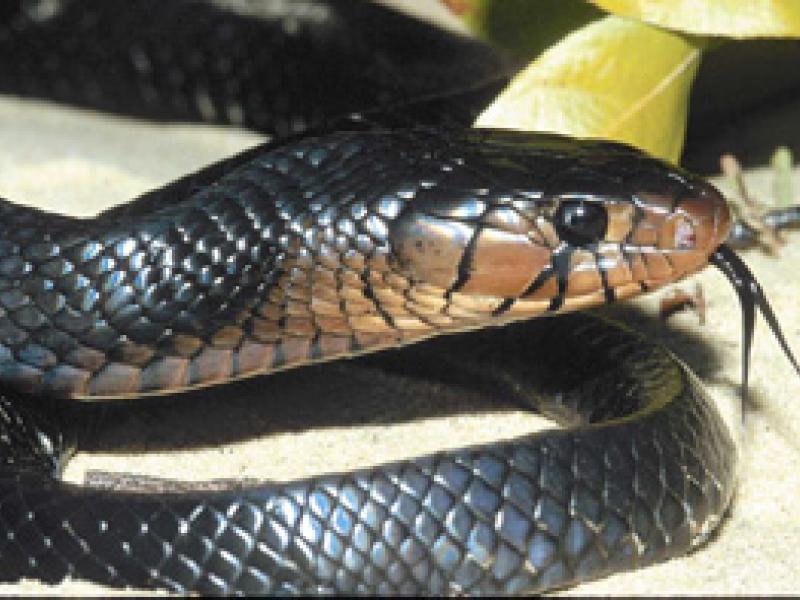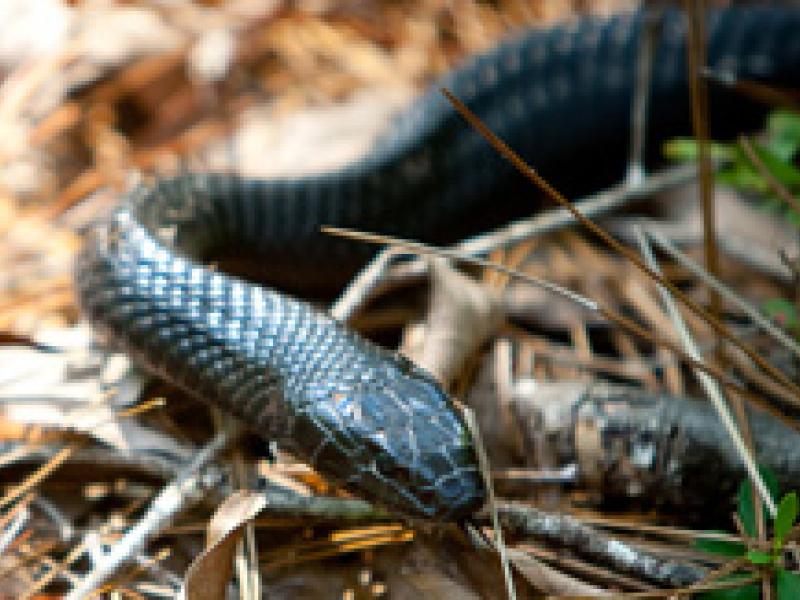Photo Credit: Dan Hipes
SCIENTIFIC NAME:
Drymarchon corais couperi
OTHER NAMES:
Blue Indigo Snake, Gopher Snake, or Bull Snake
STATUS:
ADCNR and other conservation groups are currently leading an effort to reintroduce the nonvenomous Eastern indigo snake to the Conecuh National Forest in south Alabama. Prior to these reintroduction efforts, the last wild indigo snake observed in Alabama was in the 1950s. State conservation efforts experienced a milestone in 2019 when the first wild born Eastern indigo snake was discovered in the Conecuh National Forest. Listed as threatened by the U.S. Fish and Wildlife Service. HIGHEST CONSERVATION CONCERN.
DESCRIPTION:
The Eastern Indigo Snake is a large nonvenomous, stout bodied snake averaging six to seven feet in length. The largest individual recorded was eight-and-a-half-feet. The Indigo Snake is smooth scaled and uniform glossy blue-black throughout its body except for some reddish orange or cream color suffusion on its throat, cheeks and chin. This coloration varies with some individuals having distinct coloration and others with no coloration.
Smaller indigo snakes are easily mistaken for the common black racer. Close examination is required to tell them apart. The common black racer is a slender, fast moving snake. The indigo snake is a stout, slow-moving snake. A distinct difference between the indigo snake and the black racer is the anal plate which is entire on the indigo and divided on the black racer. Another snake that is sometimes mistaken for the indigo snake is the black pine snake. Black pine snakes inhabit some of the same geographic locations as the indigo, but are easily differentiated. Black pine snakes have keeled scales. The indigo snake has smooth scales.
DISTRIBUTION:
There are eight species in the genus Drymarchon worldwide. Two species occur in the continental United States. The Eastern Indigo Snake inhabits the southeastern U.S. including Alabama. The Texas Indigo Snake is found in south Texas and Mexico.
The historical range of the Eastern Indigo Snake was from the east coast of South Carolina down thru southern Georgia, Florida, into south Alabama and southwest Mississippi. Today it is known only to naturally occur in southern Georgia and Florida. In Alabama, the Eastern Indigo Snake was studied and reintroduced in its historical range within the state. Research done in the 1980s included releases in Autuaga, Baldwin, Bullock, Covington, Escambia, Mobile and Washington counties. During the research study, reintroduced snakes were recaptured and known to be thriving on some of the restocked areas. There have been sightings of Indigo Snakes in Alabama, but a concerted effort to revisit these study areas by wildlife professionals is needed.
Habitat:
The habitats used by the indigo snake differ based on climactic conditions. In the extreme southern reaches of its range (South Florida), the snake is less restricted and inhabits flatwoods, tropical hammocks, dry glades and moist bogs. In this region of its range, overwintering sites include tree stumps and other underground dens. In the northern portion of its range, including south Alabama, the indigo snake requires deep sand ridges and is often associated with the gopher tortoise. The Indigo Snake is dependent upon the deep burrows dug by the gopher tortoise and uses them as a refuge from the extreme hot and cold temperatures. This restricted habitat is even more isolated by the snakes preference for the interspersion of wet lowlands like swamps and cypress ponds. These preferred areas are usually found where rivers and creeks run thru sandhills habitat.
LIFE HISTORY AND ECOLOGY:
Indigos are found in the lower coastal plain along with the burrowing gopher tortoise. They use the burrows not only for refuge, but also for breeding and reproduction. Breeding season occurs between October and February. A female that occupies a burrow and is ready to be bred will attract numerous males to the burrow. Once bred, the female will use burrows as egg deposition sites. The eggs are laid in clutches of nine eggs per clutch, hatching 90 to 120 days later. After hatching, the young snakes move to low wetland areas and feed on small lizards, frogs and toads. Adult snakes feed on small mammals, birds, and snakes, with a preference for snakes. The indigo snake is thought to be the main predator of the eastern diamondback rattlesnake and data has shown the rattlesnake to be a preferred food item. Adult indigo snakes will eat smaller juvenile indigo snakes.
CLASSIFICATION:
The eastern indigo snake is classified federally as threatened and is protected. It is also protected in Alabama under the non-game regulation.
Author:
James Altiere








